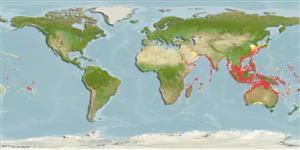>
Eupercaria/misc (Various families in series Eupercaria) >
Lutjanidae (Snappers) > Lutjaninae
Etymology: Lutjanus: Malay, ikan lutjan, name of a fish.
More on author: Forsskål.
Environment: milieu / climate zone / depth range / distribution range
Οικολογία
Θαλασσινό(ά); Γλυκού νερού; Υφάλμυρο Υφαλόφιλο(α); ωκεανόδρομο(ς) (Ref. 51243); εύρος βάθους 1 - 120 m (Ref. 9710). Subtropical; 16°C - 30°C (Ref. 2060); 39°N - 35°S, 26°E - 134°W (Ref. 54571)
Indo-West Pacific: East Africa to Samoa and the Line Islands, north to the Ryukyu Islands, south to Australia. Has dispersed into the eastern Mediterranean (off Lebanon) via the Suez Canal but not well established there.
Length at first maturity / Μέγεθος / Βάρος / Age
Maturity: Lm 57.0 range ? - ? cm
Max length : 150 cm TL αρσενικό/απροσδιόριστο; (Ref. 3678); common length : 80.0 cm TL αρσενικό/απροσδιόριστο; (Ref. 55); μεγ. δημοσιευμένο βάρος: 8.7 kg (Ref. 40637); μεγ. αναφερόμενη ηλικία: 31 έτη (Ref. 82366)
Ραχιαίες άκανθες (συνολικά) : 10; Μαλακές ραχιαίες ακτίνες (συνολικά) : 13 - 14; Εδρικές άκανθες: 3; Μαλακές εδρικές ακτίνες: 8. This species is distinguished by the following characters: body moderately deep, greatest depth 2.3 - 2.7 in SL; preopercular notch poorly developed; vomerine tooth patch crescentic; gill rakers of first gill arch 6-8 + 9-12 = 16-20 (including rudiments); scale rows on back more or less parallel to lateral line, or parallel below spinous part of dorsal fin and sometimes rising obliquely posteriorly, or rarely with entirely oblique rows. Colour of the body generally greenish brown on back, grading to reddish; belly silvery or whitish (deep water specimens usually overall reddish); juveniles with a series of about 8 white and streaks 2 blue across cheeks (Ref. 9821, 90102).
A euryhaline species (Ref. 12743). Juveniles and young adults occur in mangrove estuaries, the lower reaches of freshwater streams (Ref. 30573, 48635, 44894) and tidal creeks (Ref. 44894). Adults are often found in groups around coral reefs (Ref. 9710). Eventually migrate offshore to deeper reef areas, sometimes penetrating to depths in excess of 100 m. Mainly nocturnal, this species feeds mostly on fishes and crustaceans. Excellent food fish (Ref. 5484, 44894). An important market species throughout the Indo-Pacific region, but never found in large quantities. A good aquaculture species because it doesn’t get rancid easily when frozen (Ref. 47992). It commands a good export market price with no limit on body size (Ref. 47992). No reported damaging diseases (Ref. 47992). Found in Hong Kong live fish markets (Ref. 27253). Caught mainly with handlines, bottom longlines, and trawls; marketed mostly fresh and dried-salted (Ref. 9821). Maximum length is 104 cm, max weight 14.5 kg and max age 39 years for specimens from the east coast of Australia (pers. comm., Andrew McDougall, 2007).
Allen, G.R., 1985. FAO Species Catalogue. Vol. 6. Snappers of the world. An annotated and illustrated catalogue of lutjanid species known to date. FAO Fish. Synop. 125(6):208 p. Rome: FAO. (Ref. 55)
IUCN Red List Status (Ref. 130435)
Threat to humans
Reports of ciguatera poisoning (Ref. 31637)
Human uses
αλιεία: Εμπορικό(ά); Υδατοκαλλιέργειες: Εμπορικό(ά); αλιεία αναψυχής: ναί
Εργαλεία
Special reports
Download XML
Διαδικτυακές πηγές
Estimates based on models
Preferred temperature (Ref.
123201): 24.3 - 29.1, mean 28 °C (based on 2180 cells).
Phylogenetic diversity index (Ref.
82804): PD
50 = 0.5000 [Uniqueness, from 0.5 = low to 2.0 = high].
Bayesian length-weight: a=0.01514 (0.01331 - 0.01721), b=2.97 (2.95 - 2.99), in cm total length, based on LWR estimates for this species (Ref.
93245).
Τροφικό Επίπεδο (Ref.
69278): 3.6 ±0.5 se; based on diet studies.
Generation time: 5.9 ( na - na) years. Estimated as median ln(3)/K based on 1
growth studies.
Ελαστικότητα (Ref.
120179): Μεσαίο(α), ελάχιστος χρόνος για διπλασιασμό πληθυσμού 1,4 - 4,4 έτη (K=0.19; tmax=18).
Prior r = 0.51, 95% CL = 0.34 - 0.76, Based on 1 data-limited stock assessment.
Fishing Vulnerability (Ref.
59153): High vulnerability (60 of 100).
Climate Vulnerability (Ref.
125649): Very high vulnerability (80 of 100).
Nutrients (Ref.
124155): Calcium = 11.7 [6.2, 19.8] mg/100g; Iron = 0.299 [0.169, 0.563] mg/100g; Protein = 19.4 [17.9, 20.7] %; Omega3 = 0.182 [0.103, 0.321] g/100g; Selenium = 40.6 [19.2, 86.0] μg/100g; VitaminA = 58.9 [10.1, 305.8] μg/100g; Zinc = 0.253 [0.175, 0.398] mg/100g (wet weight); based on
nutrient studies.
